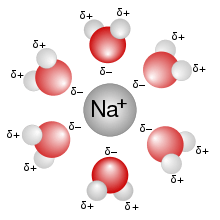Aqueous solution
An aqueous solution is a solution in which the solvent is water. It is mostly shown in chemical equations by appending (aq) to the relevant chemical formula. For example, a solution of table salt, or sodium chloride (NaCl), in water would be represented as Na+(aq) + Cl−(aq). The word aqueous (which comes from aqua) means pertaining to, related to, similar to, or dissolved in, water. As water is an excellent solvent and is also naturally abundant, it is a ubiquitous solvent in chemistry. Aqueous solution is water with a pH of 7.0 where the hydrogen ions (H+) and hydroxide ions (OH−) are in Arrhenius balance (10−7).

A non-aqueous solution is a solution in which the solvent is a liquid, but is not water.[1]
Substances that are hydrophobic ('water-fearing') often do not dissolve well in water, whereas those that are hydrophilic ('water-friendly') do. An example of a hydrophilic substance is sodium chloride. Acids and bases are aqueous solutions, as part of their Arrhenius definitions.
The ability of a substance to dissolve in water is determined by whether the substance can match or exceed the strong attractive forces that water molecules generate between themselves. If the substance lacks the ability to dissolve in water, the molecules form a precipitate.
Reactions in aqueous solutions are usually metathesis reactions. Metathesis reactions are another term for double-displacement; that is, when a cation displaces to form an ionic bond with the other anion. The cation bonded with the latter anion will dissociate and bond with the other anion.
Aqueous solutions that conduct electric current efficiently contain strong electrolytes, while ones that conduct poorly are considered to have weak electrolytes. Those strong electrolytes are substances that are completely ionized in water, whereas the weak electrolytes exhibit only a small degree of ionization in water.
Nonelectrolytes are substances that dissolve in water yet maintain their molecular integrity (do not dissociate into ions). Examples include sugar, urea, glycerol, and methylsulfonylmethane (MSM).
When writing the equations of aqueous reactions, it is essential to determine the precipitate. To determine the precipitate, one must consult a chart of solubility. Soluble compounds are aqueous, while insoluble compounds are the precipitate. There may not always be a precipitate.
When performing calculations regarding the reacting of one or more aqueous solutions, in general one must know the concentration, or molarity, of the aqueous solutions. Solution concentration is given in terms of the form of the solute prior to it dissolving.
Aqueous solutions may contain, especially in alkaline zone or subjected to radiolysis, hydrated atomic hydrogen an hydrated electron.
See also
| Look up aqueous solution in Wiktionary, the free dictionary. |
- Metal ions in aqueous solution
- Acidity function
- Solubility
- Dissociation (chemistry)
- Acid-base reaction theories
- Properties of water
- Solvated electron
References
- "Solutions". Washington University Chemistry Department. Washington University. Retrieved 13 April 2018.
- Zumdahl S. 1997. Chemistry. 4th ed. Boston: Houghton Mifflin Company. p 133–145.